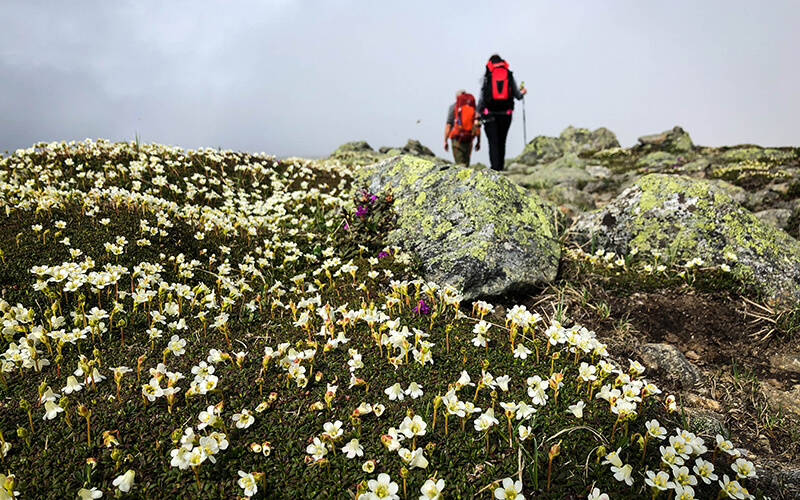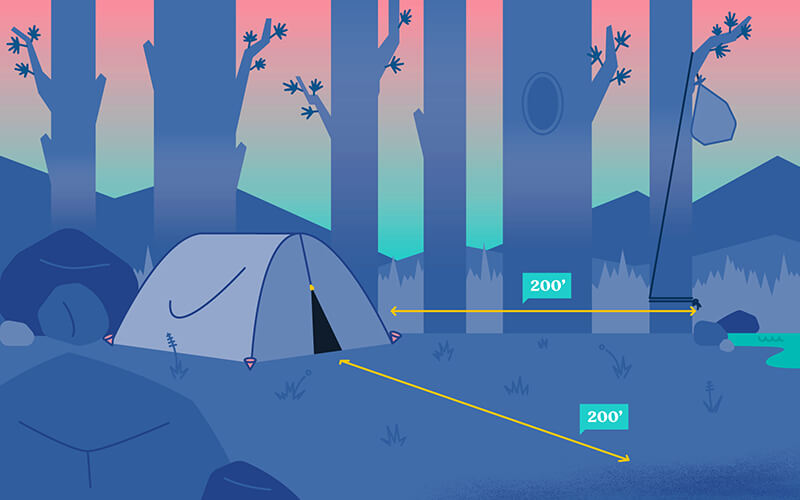Leave No Trace: Travel and Camp on Durable Surfaces

When spending time outdoors, it’s important to minimize your impacts on the fragile ecosystem you are visiting. Take the Alpine Garden just below Mount Washington’s summit: among the boulders grow Alpine azaleas and Lapland rosebay, small but essential plants that may withstand the mountain’s famously strong winds, but not the tread of hiking boots.
Leave No Trace requires that during any recreation outing, from picnicking in a park to hiking the Appalachian Trail, that outdoor users remain on designated paths and durable surfaces.
“It is important to consolidate our recreation-related impacts to these hardened surfaces designed to withstand visitor use,” explains Alex Delucia, Leave No Trace programs manager for AMC. “Hiking off trail, especially in fragile alpine environments of the Northeast, can cause significant damage to vegetation and contribute to erosion and soil loss.”
Leaving the trail can also create unauthorized or secondary paths, scarring the otherwise unbothered landscape by repeatedly trampling over the same route.

Stick to the trails
The easiest way to minimize your impact is by limiting travel to preexisting trails. AMC and other organizations regularly build and maintain trails, providing guided routes that are nearly free of vulnerable plant life. By sticking to these paths, you avoid causing further damages to the land and limit erosion to the designated areas.
Occasionally, you may need to step off the trail, whether to let someone pass on a narrow section or to take a bathroom break. During any of these instances, it’s important to still minimize your impact by standing on durable surfaces—rocks, sand, gravel, ice, or snow—instead of on moss or other fragile vegetation.
According to Leave No Trace, some plant life, like dry grass, is more resistant to trampling than others. However, consistent trampling over the same area will lead to new, unauthorized pathways, so Leave No Trace advises that if you do need to travel off trail to avoid taking the same route as others. Delucia adds that travelers should choose less popular trails to help minimize the effects of overuse.
NOTE: Given the added risks around COVID-19, it is more important than ever to leave distance between ourselves and others on the trails. Delucia advises that if planning a trip, choose a trail or location that is less popular to avoid crowds, and if we do need to pass someone, to be on the lookout for those durable surfaces that give them some extra space. This may mean we will wait a little longer for someone to pass, so patience is key.

Camp at designated sites when possible
When you plan to camp, it’s important we first research the area to which you are traveling and learn the rules. Delucia recommends camping at designated campgrounds or backcountry tent sites over camping off-trail (sometimes called “stealth camping” or “pristine camping”), even when allowed.
“If pristine camping is permitted there are ways to limit your impacts and make efforts to ensure no one will use that site again after you leave,” Delucia says.
These sites should be at least 200 feet from the trail and any water sources, according to Delucia, although it may need to be moved farther if the leaf cover is light and a campsite can be seen from the trail. In winter, the lack of leaf cover requires visitors to travel more than 200 feet off trail to prevent being seen.
Build camp somewhere that requires no modifications—like cutting down branches or removing plants—to accommodate the tent, cooking area, and bear hang or cannister. Remember, the goal is to minimize your impact to the environment, so relegating the campsite to durable surfaces is preferable, whenever possible. Do not build campfires at pristine camping sites. In winter, snowpack can provide a very durable surface as long as it is deep enough to not disturb the vegetation under the snow, making campsite selection much easier, he adds.
“After your night at that site, pack up your gear, naturalize the area with leaf litter and branches, and return to the trail via a different route,” Delucia adds. “Hopefully there will be no sign that you were ever there.”




